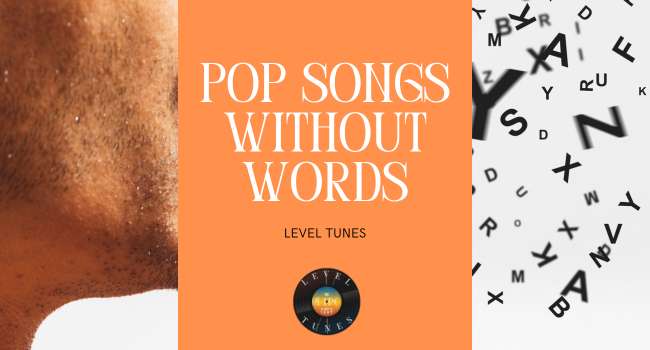11 Pop Songs Without Words: Top Instrumental Hits
Hey there, fellow music lovers and DJs! It’s TBone here, your guide through the electrifying world of music from the helm of Level Tunes.
With 20 years in the industry, I’ve seen trends come and go, but one thing remains the same – the universal language of music, especially the kind without words.
Pop instrumentals have a special place in my heart, and today, I’m thrilled to share a curated list of 11 pop songs sans lyrics. Why these songs, you ask?
Well, through my journey, I’ve discovered that sometimes music without words speaks volumes, allowing our emotions and imagination to run wild. These tracks are handpicked for their ability to connect, energize, and inspire, embodying the essence of what I love about this genre.
So, get ready to explore the unspoken magic of pop with me!
Here are the pop songs without words that you can check out:
List Of Pop Songs Without Words
1. “E.V.A.” by Jean-Jacques Perrey
Album: Moog Indigo, 1970
Label: Vanguard Records
Jean-Jacques Perrey’s “E.V.A.” is a quintessential electronic pop odyssey, released at a time when the Moog synthesizer was revolutionizing music. From the album “Moog Indigo,” this 1970 masterpiece under Vanguard Records blends playful melodies with futuristic sounds, capturing the imagination of listeners. Perrey, a pioneer of electronic music, utilizes the Moog with such creativity that “E.V.A.” feels both of its time and timeless. The track’s joyful, bouncy rhythm and intricate layers make it an enduring favorite. Its influence can be heard in hip-hop samples and remixes, attesting to its lasting appeal. I chose this song for its innovative use of technology in music, showcasing how electronic sounds can create a rich, emotive pop experience.
2. “Green Onions” by Booker T. & the M.G.’s
Album: Green Onions, 1962
Label: Stax Records
“Green Onions” by Booker T. & the M.G.’s is a sultry, soul-infused instrumental that has become synonymous with cool. Released in 1962 as part of their album of the same name on Stax Records, this track features Booker T. Jones on the Hammond organ, Steve Cropper on guitar, Lewie Steinberg on bass, and Al Jackson Jr. on drums. The groove is irresistible, driven by a bluesy organ riff and a steady backbeat that makes it impossible not to nod along. What I adore about “Green Onions” is its timeless vibe, effortlessly bridging genres and generations. It’s a testament to the power of simple, effective musicianship and the deep-rooted connection between pop and soul.
3. “Misirlou” by Dick Dale
Album: Surfer’s Choice, 1962
Label: Deltone Records
Dick Dale’s “Misirlou” is a thunderous display of surf rock’s electrifying energy, catapulting listeners straight into the heart of the 1960s surf scene. Featured on his 1962 album “Surfer’s Choice,” released through Deltone Records, Dale’s rapid-fire, reverb-laden guitar technique became a defining sound of the era. “Misirlou” is a thrilling musical ride, with its Eastern Mediterranean influences and breakneck pace showcasing Dale’s virtuosity. This track is chosen for its cultural significance and its role in popularizing surf rock, a genre that combines infectious rhythms with the raw power of electric guitar. Dale’s performance is a masterclass in emotion and technical skill, making “Misirlou” an unforgettable instrumental classic.
4. “Frankenstein” by The Edgar Winter Group
Album: They Only Come Out at Night, 1972
Label: Epic Records
The Edgar Winter Group’s “Frankenstein” is an electrifying tour de force from their 1972 album “They Only Come Out at Night,” released on Epic Records. This instrumental track stands out for its innovative use of the synthesizer and saxophone, alongside a heavy rock beat. Edgar Winter’s prowess on multiple instruments, including the keyboard and sax, drives the song’s dynamic shifts and intense energy. “Frankenstein” earned its name from the extensive editing and splicing involved in its creation, resembling a musical version of the monster’s assembly. Its fusion of rock, jazz, and funk elements is why I selected it; it’s a thrilling example of how instrumental music can convey power and excitement without a single word.
5. “Love’s Theme” by Love Unlimited Orchestra
Album: Rhapsody in White, 1974
Label: 20th Century Records
Barry White’s Love Unlimited Orchestra brought us “Love’s Theme” from the 1974 album “Rhapsody in White,” on 20th Century Records. This lush, orchestral piece is dripping with romance, characterized by its sweeping strings, brass, and a catchy melody that floats above an irresistible disco beat. Barry White’s vision for a grand, cinematic sound in pop music is fully realized here, making “Love’s Theme” a standout track for its sheer beauty and emotional depth. I chose this song for its embodiment of the 1970s’ luxurious soundscapes, proving instrumental tracks can be as moving and soulful as any vocal performance.
6. “TSOP (The Sound of Philadelphia)” by MFSB featuring The Three Degrees
Album: Love Is the Message, 1973
Label: Philadelphia International Records
“TSOP (The Sound of Philadelphia)” by MFSB, featuring vocal embellishments by The Three Degrees, is an anthem of the 1970s soul and disco era. Released as part of their 1973 album “Love Is the Message” on Philadelphia International Records, this track epitomizes the smooth, sophisticated sound of Philly soul. The lush string arrangements, tight horn sections, and groovy bass lines, combined with the iconic “Soul Train” theme, make “TSOP” an unforgettable piece. I love how it captures the essence of a vibrant musical movement, blending orchestral elegance with dance-floor readiness. Its joyous vibe and polished production highlight the collective talent of MFSB, marking “TSOP” as a seminal instrumental in pop history.
7. “Peaches en Regalia” by Frank Zappa
Album: Hot Rats, 1969
Label: Bizarre/Reprise Records
Frank Zappa’s “Peaches en Regalia,” from his 1969 album “Hot Rats” on Bizarre/Reprise Records, is a brilliantly intricate composition that melds jazz, rock, and pop into a seamless, avant-garde masterpiece. This track showcases Zappa’s genius for arrangement and his ability to blend diverse musical styles. With its complex harmonies, shifting rhythms, and a melody that’s both whimsical and sophisticated, “Peaches en Regalia” is a testament to Zappa’s innovative spirit. I selected this song for its adventurous approach to instrumental music, demonstrating how boundary-pushing compositions can create a deeply engaging and endlessly fascinating listening experience.
8. “Jessica” by The Allman Brothers Band
Album: Brothers and Sisters, 1973
Label: Capricorn Records
“Jessica” by The Allman Brothers Band, featured on their 1973 album “Brothers and Sisters” released by Capricorn Records, is a sun-soaked journey through southern rock and jazz fusion. This instrumental is celebrated for its uplifting melody, led by Dickey Betts’ harmonious guitar work and complemented by Gregg Allman’s organ playing. “Jessica” evokes the feeling of a carefree drive down a country road, embodying the spirit of freedom and adventure. The song’s seamless blend of rock virtuosity and soulful melodies is why it’s on this list. It’s a brilliant example of how music can paint vivid pictures and tell stories, all without uttering a single word.
9. “Rockit” by Herbie Hancock
Album: Future Shock, 1983
Label: Columbia Records
Herbie Hancock’s “Rockit,” from his 1983 album “Future Shock” on Columbia Records, is a groundbreaking track that fused jazz, funk, and hip-hop elements, bringing scratching and turntablism to the mainstream. Its innovative video further cemented its place in pop culture. “Rockit” is notable for its robotic synthesizer bass line and complex scratching sequences, showcasing Hancock’s forward-thinking approach to music. I chose this track for its significant impact on the evolution of electronic music and its role in bridging the gap between jazz, pop, and hip-hop. Hancock’s mastery in creating a sound that was both ahead of its time and deeply groovy makes “Rockit” a pivotal instrumental piece.
10. “Soulful Strut” by Young-Holt Unlimited
Album: Soulful Strut, 1968
Label: Brunswick Records
“Soulful Strut” by Young-Holt Unlimited, the title track from their 1968 album released by Brunswick Records, is a smooth, jazzy instrumental that exudes coolness and sophistication. Though often mistaken for a purely instrumental track, its foundation was actually the backing track for Barbara Acklin’s vocal performance on “Am I the Same Girl.” “Soulful Strut” shines with its laid-back piano melodies, elegant bass lines, and a gentle, swaying rhythm. The song’s charm lies in its simplicity and effortless groove, making it a staple of easy-listening playlists. I admire its ability to create a mood that’s both relaxing and invigorating, encapsulating the essence of soulful instrumental music.
11. “Axel F” by Harold Faltermeyer
Album: Beverly Hills Cop Soundtrack, 1984
Label: MCA Records
“Axel F” by Harold Faltermeyer, from the 1984 “Beverly Hills Cop” soundtrack on MCA Records, is an iconic synthesizer-driven track known for its catchy melody and association with the film’s cheeky and charismatic protagonist, Axel Foley. Faltermeyer crafted a piece that’s not only emblematic of the 1980s’ electronic music boom but also a timeless pop instrumental. Its bouncy bass line, bright synth leads, and memorable hooks capture the era’s optimistic, high-energy vibe. “Axel F” stands out for its ability to immediately evoke a sense of nostalgia and fun, making it a cultural touchstone. I love how it combines technical prowess with a playful spirit, illustrating the power of instrumental music to transcend its context and become a universally recognized anthem. The genius of “Axel F” lies in its synthesis of electronic music techniques, catchy composition, and its role in defining the soundtrack of the 80s. It’s a testament to how instrumental tracks can capture the imagination and endure across generations, making it a perfect closer for this list
Fun Facts: Pop Songs Without Words
“E.V.A.” by Jean-Jacques Perrey
- Fact: “E.V.A.” has been sampled by numerous hip-hop artists over the years, most notably by Gang Starr in the track “Just to Get a Rep” and by Fatboy Slim in “Praise You.” Its funky beat and catchy melody have made it a favorite among producers looking to add a vintage electronic vibe to their tracks.
“Green Onions” by Booker T. & the M.G.’s
- Fact: The song “Green Onions” was originally a B-side to a track called “Behave Yourself” and was recorded during a spontaneous jam session. Its unexpected popularity turned it into one of the most recognizable instrumental tracks in music history, and it has been used in countless movies, commercials, and TV shows to evoke a cool, retro vibe.
“Misirlou” by Dick Dale
- Fact: “Misirlou,” a traditional Eastern Mediterranean song, was popularized in the West by Dick Dale in 1962. Dale’s version became a surf rock anthem thanks to its blistering pace and use of reverb, which would go on to influence the sound of surf music. The song gained a second life in popular culture when it was used as the opening theme in Quentin Tarantino’s film “Pulp Fiction.”
“Frankenstein” by The Edgar Winter Group
- Fact: The song “Frankenstein” earned its name because of the extensive editing and splicing involved in its creation, making the final product a ‘monster’ of a track. Interestingly, it was one of the first rock songs to feature a synthesizer as the lead instrument, showcasing Edgar Winter’s innovation in rock music.
“Love’s Theme” by Love Unlimited Orchestra
- Fact: “Love’s Theme” is one of the earliest examples of disco music making its way into mainstream pop. Its lush orchestration and smooth melody paved the way for the disco explosion in the late 1970s. Barry White’s Love Unlimited Orchestra was known for bringing a cinematic scope to R&B, and “Love’s Theme” remains one of the most enduring instrumental tracks from that era.
“TSOP (The Sound of Philadelphia)” by MFSB featuring The Three Degrees
- Fact: “TSOP” was originally the theme song for the TV show “Soul Train,” which was instrumental in bringing soul, R&B, and later disco music to a nationwide audience. The song’s title, “The Sound of Philadelphia,” reflects the city’s influential role in the development of soul music and its smooth, lush production style.
“Peaches en Regalia” by Frank Zappa
- Fact: Frank Zappa considered “Peaches en Regalia” one of his favorite compositions, and it has since become one of his most performed pieces. The song showcases Zappa’s complex musical arrangements and has been covered by many artists across different genres, illustrating its wide appeal and Zappa’s influence on music.
“Jessica” by The Allman Brothers Band
- Fact: “Jessica” was named after guitarist Dickey Betts’ daughter. He was inspired to write the song when he observed her bouncing around the room. The track is known for its upbeat melody and has become a symbol of the Southern rock genre, embodying the spirit of freedom and joy.
“Rockit” by Herbie Hancock
- Fact: “Rockit” is notable for being one of the first mainstream singles to feature scratching and other turntablism techniques, introducing a wider audience to elements of hip-hop culture. The accompanying music video, featuring robotic mannequins and other surreal imagery, was groundbreaking and won several awards, further cementing the song’s place in music history.
“Soulful Strut” by Young-Holt Unlimited
- Fact: Interestingly, “Soulful Strut” is essentially an instrumental version of Barbara Acklin’s song “Am I the Same Girl.” The instrumental track gained more fame than the original vocal version, showcasing the power of its melody and arrangement to stand on its own.
“Axel F” by Harold Faltermeyer
- Fact: “Axel F” stands for Axel Foley, the name of Eddie Murphy’s character in “Beverly Hills Cop.” The song’s catchy synthesizer melody became instantly recognizable and is often associated with the 1980s electronic music scene. The track’s success led to numerous covers and remixes, including a 2005 hit version by Crazy Frog, which introduced the tune to a new generation.
Exploring these 11 instrumental pop gems has been a musical journey through time, showcasing the rich tapestry of sounds and styles that define our beloved genre.
Each track, a masterpiece in its own right, reminds us why music without words can sometimes speak the loudest. Join us again for more melodic adventures that transcend words and bring the soul of the past into the present.
Thanks for reading.
TBone




